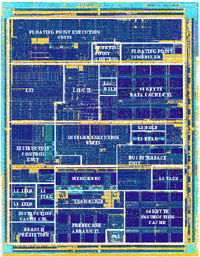The Basics
The Athlon is the first non-Intel x86 CPU to move away from the conventional socketed design in favor of a slot interface connector. Intel made the move to the 242-pin Slot-1 connector with the Pentium II and received quite a bit of heat for doing it, with accusations of them attempting to kill all competition with this proprietary connector. In all fairness, all you Intel supporters now have the right to say the same thing about AMD :)
But regardless of what company you support, the truth of the matter is that a slot design is easier on the user from the point of installation. Ask any system builder and he/she will tell you that sticking in a Slot-1 processor without the fear of bending pins is much easier than working with a socketed CPU.
The Athlon interfaces using a 242-pin slot connector known as Slot-A. Before you get excited about AMD's decision to use a 242-pin slot connector, the only reason AMD chose to implement a physically similar slot connector to Slot-1 was to make it easier on the motherboard manufacturers. Instead of having to worry about new PCB designs and connectors, motherboard manufacturers can simply reuse most of their basic designs, flip their Slot-1 connectors around, and have the start of a Slot-A motherboard.
Intel's 242-pin Slot-1 connector
![]()
AMD's 242-pin Slot-A connector
![]()
The 242-pin Slot-A connector is essentially a Slot-1 connector, flipped backwards. The reasoning behind this is simple, it looks like a Slot-1 connector, but neither you nor AMD wants a user trying to stick a Slot-1 processor in a Slot-A motherboard, why? Because although Slot-1 and Slot-A are physically similar, the interfaces provide a connection to two completely different architectures, meaning that you can't just plug one processor into the other slot. The differing architectures will be discussed shortly, but first let's talk about the CPU.
The Athlon is manufactured on a 0.25-micron fabrication process, the standard for both Intel and AMD currently. At the same time, there are plans to move the Athlon to 0.18-micron production definitely in the year 2000 if not earlier. Intel is preparing the same move with their Coppermine processor later this year, however AMD isn't blessed with the same fab plants Intel has worked hard for so the Athlon will currently ship on a 0.25-micron die.
| The 184 mm2 die is composed of 22 million transistors, the highest transistor count for an x86 processor's core to date. A large portion of the 22 million transistors is dedicated to the 128KB of L1 cache the Athlon boasts, an increase over the 64KB L1 on the K6-3 and the 32KB L1 on the Pentium III. The real world benefits of a large L1 cache are mainly seen in business application performance, especially with applications that fit directly into the L1 cache of the processor. Operating at the clock speed of the processor, the 128KB of L1 gives the Athlon a major advantage in terms of business application performance, an area that has always been a strongpoint for AMD. |











2 Comments
View All Comments
vortmax - Wednesday, September 6, 2006 - link
Go AMD!jonmssith - Tuesday, May 18, 2021 - link
your personal experienceMindfully using our emotions as data about our inner state and knowing when it’s better to de-esc https://kodi.software/ alate by taking a time out are great tools. Appreciate you reading and sharing your story, since I can certainly relate and I think others can too